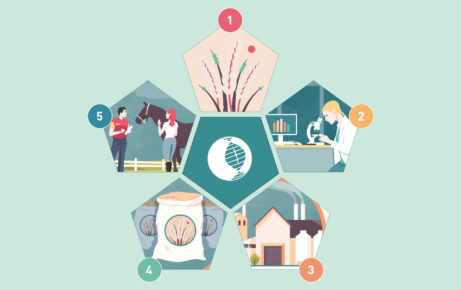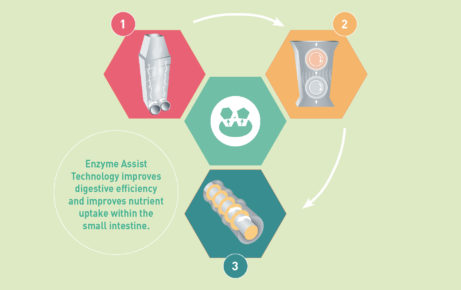消化

The Mouth
The mouth is the start of the digestive system. The horse uses its front teeth (incisors) to cut food. The back teeth (premolars and molars) grid the food into smaller pieces. Chewing triggers the production of saliva. This lubricates the food to help it pass through the oesophagus. Saliva also contains bicarbonate ions which help to buffer gastric acid. Restriction of forage, which results in reduced saliva production, is one of the key factors in the development of gastric ulcers. A horse should eat a minimum of 1.5% of its bodyweight in forage (dry matter) each day.
The Oesophagus
When the horse swallows the epiglottis blocks the trachea so that food doesn’t enter the airway, and the chewed food enters the oesophagus. The wall of the oesophagus has smooth muscle which contracts and pushes the food into the stomach, a process known as peristalsis. The horse cannot vomit and if food becomes stuck in the oesophagus this can cause a condition known as choke.
The Stomach
The horse is a herbivore which evolved to graze for around 18 hours every day and has a very small stomach. The stomach naturally secretes acids to begin the break down the food into smaller particles. When feeding concentrates such as cubes, mixes or straight cereals it is important to feed as many small meals a day as possible.
The Small Intestine
Cereals, cubes and mixes are digested in the small intestine and provide the horse with energy, proteins, oils, vitamins and minerals. The feed moves through the small intestine in a matter of hours, so it is important to feed a highly digestible feed to get the most nutrition for your horse.
All RED MILLS feeds are carefully cooked. We use steam flaking, extrusion and double pelleting to ensure we achieve maximum digestibility in all of our feeds. Our onsite laboratory monitors the YSI – cook value. Our unique process directly benefits your horse through optimum digestion in the small intestine.
If the food is not digested properly it flows through to the large intestine where it can cause problems such as laminitis, colics and “bad behaviour” as undigested particles encourage the growth of bad bacteria and unbalances the digestive system.
The Large Intestine
Forages and super fibres are digested in the large intestine by bacteria. Forages are not just for satisfying the horses’ appetite and are a good source of energy and some vitamins. The best sources of fibre for your horse are grass, hay and haylage. In our feed we use Super Fibres which are fibre sources with a higher energy content, such as soya bean hulls and sugar beet pulp which offer an alternative source of energy to cereals. You should always provide good grass, hay or haylage for your horse every day.



